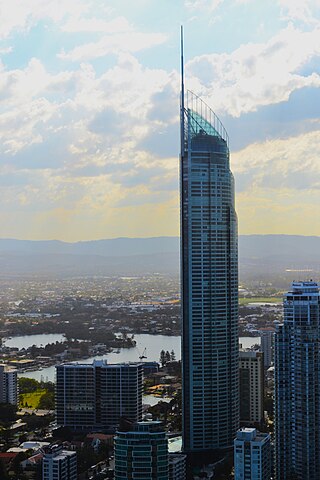
Queensland is a state in north-eastern Australia, the second-largest and third-most populous of the Australian states. It is bordered by the Northern Territory, South Australia and New South Wales to the west, south-west and south respectively. To the east, Queensland is bordered by the Coral Sea and the Pacific Ocean; to its north is the Torres Strait, separating the Australian mainland from Papua New Guinea, and the Gulf of Carpentaria to the north-west. With an area of 1,729,742 square kilometres (667,857 sq mi), Queensland is the world's sixth-largest sub-national entity; it is larger than all but 16 countries. Due to its size, Queensland's geographical features and climates are diverse, including tropical rainforests, rivers, coral reefs, mountain ranges and sandy beaches in its tropical and sub-tropical coastal regions, as well as deserts and savanna in the semi-arid and desert climatic regions of its interior.

The Gold Coast, often referred to by its initials G.C., and officially the City of Gold Coast, is a city in Queensland, Australia. It is Australia’s sixth-largest city, the most populous non-capital city, and the state's second-largest city after Brisbane, with a population over 600,000. The Gold Coast is a coastal city and region located approximately 66 kilometres (41 mi) south-southeast of the centre of the state capital, Brisbane. The city's central business district is located roughly in the centre of the Gold Coast in the suburb of Southport. The urban area of the Gold Coast is concentrated along the coast, sprawling almost 60 kilometres, joining up with the Greater Brisbane metropolitan region to the north and to the state border with New South Wales to the south. Nicknames of the city include the ‘Glitter Strip’ and the ‘Goldy’. The demonym of a Gold Coast resident is Gold Coaster.

Tourism in Australia is an important part of the Australian economy, and comprises domestic and international visitors. Australia is the fortieth most visited country in the world according to the World Tourism Organization. In the financial year 2018/19, tourism was Australia's fourth-largest export and over the previous decade was growing faster than national GDP growth. At the time it represented 3.1% of Australia's GDP contributing A$60.8 billion to the national economy.

Surfers Paradise is a suburb in the City of Gold Coast, Queensland, Australia. In the 2021 census, Surfers Paradise had a population of 26,412 people.

Q1 Tower is a 322.5-metre (1,058 ft) supertall skyscraper in Queensland, Australia. The residential tower on the Gold Coast was the world's tallest residential building from 2005 to 2011. As of 2023, it is the tallest building in Australia, the second tallest building in the Southern Hemisphere, and the third-tallest free-standing structure in the Southern Hemisphere, behind the Autograph Tower in Jakarta, Indonesia, and the Sky Tower in Auckland, New Zealand. The Q1 officially opened in November 2005.

The Sunshine Coast is a peri-urban region in South East Queensland, Australia. It is the district defined in 1967 as "the area contained in the Shires of Landsborough, Maroochy and Noosa, but excluding Bribie Island". Located 100 km (62 mi) north of the centre of Brisbane in South East Queensland, on the Coral Sea coastline, its urban area spans approximately 60 km (37 mi) of coastline and hinterland from Pelican Waters to Tewantin.

Nambour is a rural town and locality in the Sunshine Coast Region, Queensland, Australia. In the 2016 census, the locality of Nambour had a population of 11,187 people.

The 1982 Commonwealth Games was held in Brisbane, Australia, from 30 September to 9 October 1982. The Opening Ceremony was held at the QEII Stadium, in the Brisbane suburb of Nathan. The QEII Stadium was also the athletics and archery events venue. Other events were held at the purpose-built Sleeman Sports Complex in Chandler.

The Queensland Police Service (QPS) is the principal law enforcement agency responsible for policing the Australian state of Queensland. In 1990, the Queensland Police Force was officially renamed the Queensland Police Service and the old motto of "Firmness with Courtesy" was changed to "With Honour We Serve". The headquarters of the Queensland Police Service is located at 200 Roma Street, Brisbane.

The Woodford Folk Festival is an annual music and cultural festival held near the semi-rural town of Woodford, 72 km (45 mi) north of Brisbane, Queensland, Australia. It is one of the biggest annual cultural events of its type in Australia. Every year approximately 125,000 patrons attend the festival. Approximately 2000 performers and 438 events are programmed featuring local, national and international guests.

Peregian Beach is a beach and small coastal town on the Sunshine Coast, Queensland, Australia. It is a suburb split between two local government areas with the eastern coastal in the Shire of Noosa and the western hinterland part in the Sunshine Coast Region. In the 2021 census, the suburb of Peregian Beach had a population of 4,972 people.

Maleny is a rural town and locality in the Sunshine Coast Region, Queensland, Australia. Maleny was a timber town until the early 1920s and then was a centre of dairy production and fruit growing. In the 2021 census, the locality of Maleny had a population of 3,959 people.

South East Queensland (SEQ) is a bio-geographical, metropolitan, political and administrative region of the state of Queensland in Australia, with a population of approximately 3.8 million people out of the state's population of 5.1 million. The area covered by South East Queensland varies, depending on the definition of the region, though it tends to include Queensland's three largest cities: the capital city Brisbane; the Gold Coast; and the Sunshine Coast. Its most common use is for political purposes, and covers 35,248 square kilometres (13,609 sq mi) and incorporates 11 local government areas, extending 240 kilometres (150 mi) from Noosa in the north to the Gold Coast and New South Wales border in the south, and 140 kilometres (87 mi) west to Toowoomba. It is the third largest urban area in Australia by population.
Blurred is a play by Stephen Davis that focuses on schoolies week. It was written for young actors and first produced at Brisbane Festival Hall in 1999 for STAGE X as part of an initiative by the Queensland Performing Arts Trust. It was later turned into Blurred, a 2002 Australian film.

Sunshine Coast Airport is an Australian international airport located in Marcoola, 10 km (6.2 mi) north of Maroochydore, at the northern end of the Sunshine Coast. It is approximately 90 km (56 mi) north of centre of Brisbane, within the South East Queensland agglomeration. The airport is owned by Sunshine Coast Regional Council and is the principal and only jet-capable airport serving an urban area of nearly 400,000 residents.

Maroochydore is a coastal city in the Sunshine Coast Region, Queensland, Australia.
Red Frogs Australia is a Christian Youth charity run by volunteers known as the 'Red Frogs Crew'. The volunteers participate in many events that are attended by school leavers and university students such as schoolies week. Since 1997, Allens' has donated over 24 tonnes of the red frog confectionery every year. The Crew's vision is to "safeguard a generation" that is outworked through education, early intervention and harm minimisation.
Liz Cantor is an Australian television presenter. She was the winner of the reality television game show The Mole in 2005.
Brett Peter Cowan is an Australian murderer and child rapist. He was convicted of the murder of Daniel Morcombe, a 13-year-old boy who disappeared from the Sunshine Coast on 7 December 2003. His abduction led to an eight-year investigation involving various suspects. As a result of these investigations, Cowan led undercover police to a potential burial site. He was charged with the murder that same month, and Morcombe's remains were discovered days later on 17 August. Cowan was sentenced to life imprisonment, on 13 March 2014 in a trial that attracted worldwide attention. Cowan had two previous convictions for sexually abusing children, the earliest dating back to 1987.

The Big Pineapple Music Festival is held annually at the Big Pineapple Landmark, in Woombye, Queensland, Australia. The festival features a range of artists from a variety of genres and first occurred on 21 April 2013 with over 8,000 tickets purchased. The festival was initially developed by the new Big Pineapple landmark owners, in an attempt to pull the business out of bankruptcy. From 2016-2019, the festival has repeatedly sold out, with the 2019 Big Pineapple Music Festival reporting a record attendance of 16,000 people. The Big Pineapple Music Festival has consecutively won the ‘People’s Choice Award Festival of the Year’ for 2018 and 2019 at the Queensland Music Awards.
















